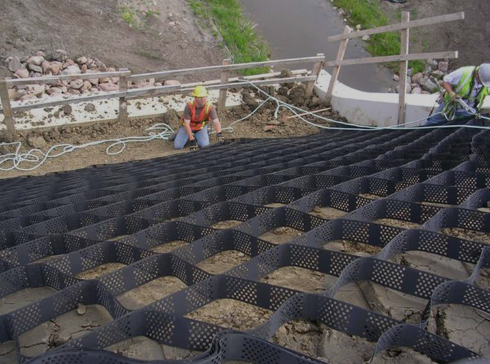- Understanding the Role of Geomembrane Liners in Waste Management
- Innovations in Geomembrane Liners for Water Management
- Geomembrane Liners: A Comprehensive Guide
- The Future of Geomembrane Liners in Civil Engineering
- Geomembrane Liners: Enhancing Landfill Stability
Manager:
WhatsApp:+86 177 0135 2670
Tel:+86 177 0135 2670
Email:marketing@okorder.com
Address:3rd Floor, No.2 Building, No.1 Sanlihe Road
What materials are used in HDPE Geocell?
Geocell slope protection is a crucial technique in civil engineering, particularly for stabilizing soil on steep slopes and preventing erosion. Geocells, also known as cellular confinement systems, are widely used for slope protection due to their versatility, durability, and cost-effectiveness. Among the various types of geocells available, those made from High-Density Polyethylene (HDPE) are highly popular. But what materials are used in hdpe geocells, and how do they contribute to effective slope protection? Let's delve into the composition of HDPE geocells and their role in slope stabilization.

Understanding Geocell Slope Protection
Before delving into the materials used in HDPE geocells, it's essential to understand the concept of geocell slope protection. Geocells are three-dimensional, honeycomb-like structures made from various materials, including plastics like HDPE. When installed on slopes, these cells confine and stabilize soil, preventing erosion and landslides. The interconnected cells create a robust framework that distributes load evenly, reinforcing the soil and enhancing its strength.
Composition of HDPE Geocells
HDPE geocells are manufactured using High-Density Polyethylene, a thermoplastic polymer known for its strength, flexibility, and resistance to various environmental conditions. The composition of HDPE geocells typically includes the following materials:
1. High-Density Polyethylene (HDPE): The primary material used in HDPE geocells is, as the name suggests, High-Density Polyethylene. HDPE is a type of plastic known for its high strength-to-density ratio, chemical resistance, and durability. It is derived from petroleum and ethylene through a polymerization process, resulting in a versatile material suitable for various engineering applications.
2. Welding Strips: HDPE geocells are assembled using specialized welding techniques to join individual panels or sheets of HDPE. Welding strips, typically made from the same HDPE material, are used to bond the panels together securely. This ensures that the geocell structure remains intact even under heavy loads and adverse environmental conditions.
3. Connection Pins or Clips: In some cases, connection pins or clips made from durable materials such as stainless steel or reinforced plastic are used to further reinforce the joints between HDPE geocell panels. These pins or clips provide additional stability and prevent lateral movement of the geocell structure, enhancing its effectiveness in slope protection applications.
4. Anti-Ultraviolet (UV) Additives: To enhance the longevity of HDPE geocells when exposed to sunlight, anti-UV additives may be incorporated into the HDPE material during the manufacturing process. These additives help protect the geocell from degradation caused by prolonged exposure to ultraviolet radiation, ensuring long-term performance and durability in outdoor environments.
5. Texturing or Perforations: Depending on the specific requirements of the slope protection application, HDPE geocells may feature texturing or perforations on the surface of the cells. These texturing or perforations serve multiple purposes, including enhancing soil interlock, promoting vegetation growth, and improving hydraulic performance by allowing water to drain freely through the geocell structure.
Advantages of HDPE Geocells in Slope Protection
The materials used in HDPE geocells contribute to several advantages that make them highly suitable for slope protection applications:
1. Strength and Durability: HDPE is renowned for its high strength and durability, making HDPE geocells capable of withstanding heavy loads and resisting environmental factors such as chemical exposure, moisture, and temperature fluctuations. This ensures long-term stability and effectiveness in slope protection projects.
2. Flexibility: HDPE geocells are flexible yet robust, allowing them to conform to the contours of the slope and adapt to changes in terrain without compromising their integrity. This flexibility facilitates easy installation and ensures optimal performance even on irregular or uneven surfaces.
3. Chemical Resistance: HDPE is inherently resistant to chemicals, including acids, alkalis, and solvents, which are commonly found in soil and water. This resistance to chemical degradation ensures that HDPE geocells remain unaffected by corrosive substances, prolonging their lifespan and maintaining their structural integrity over time.
4. Environmental Compatibility: HDPE geocells are environmentally friendly solutions for slope protection, as they are non-toxic, non-biodegradable, and recyclable. The use of HDPE geocells helps minimize environmental impact while providing effective erosion control and slope stabilization.
5. Cost-Effectiveness: Compared to traditional slope protection methods such as concrete retaining walls or riprap, HDPE geocells offer a cost-effective alternative. Their lightweight design, ease of installation, and minimal maintenance requirements result in lower overall project costs while delivering comparable or superior performance.

Conclusion
HDPE geocells play a vital role in slope protection, offering a durable, flexible, and cost-effective solution for stabilizing soil and preventing erosion on steep slopes. The materials used in HDPE geocells, including High-Density Polyethylene, welding strips, connection pins or clips, anti-UV additives, and texturing or perforations, contribute to their strength, durability, and environmental compatibility. By understanding the composition and advantages of HDPE geocells, engineers and project managers can make informed decisions when selecting slope protection solutions for their projects, ensuring long-term stability and resilience against natural hazards."






